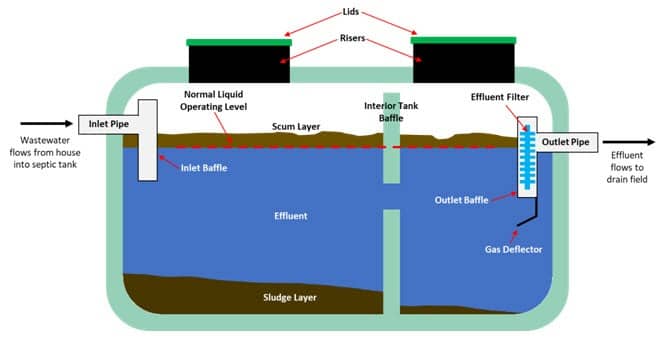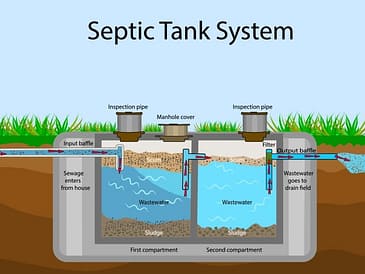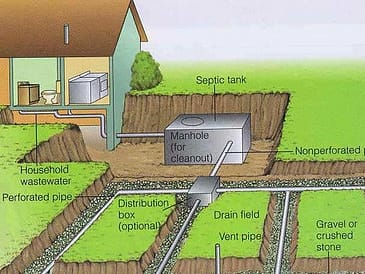
A septic inlet baffle is a great way to prevent floating scum from forming at the top of your septic tank. While it may seem like a small problem, it can lead to bigger issues over time if left unchecked. This article aims to give you a few tips on how to maintain the baffle so that it lasts a long time.
Floating scum
The septic inlet baffle is an important component of the septic tank. It helps to prevent scum from plugging the inlet pipe and clogging the absorption field.
Usually, septic tanks have an inlet and outlet baffle. If the inlet baffle does not extend above the liquid level, you will not get a clear, clean effluent.
In addition, you should check the sanitary tee in your septic system to ensure that it is not plugged. A sanitary tee is a plastic or concrete piece that is attached to the inlet and outlet pipes. You can use the lower leg of the tee to guide wastewater into the inlet.
As the septic system works, it generates bacteria. These bacteria start to multiply when there is food available. This process continues as solids accumulate in the septic tank.
When it comes to septic tanks, a certain amount of the total volume should be reserved for the sludge layer. However, some of the solids will remain in the clear zone between the scum and sludge layers.
Some of the solids will also be carried by the gas bubbles that rise to the top of the septic tank. This is the reason for the existence of the sludge layer.
The sludge layer, sometimes labeled as FOG, takes up a portion of the total volume of the septic tank. Sludge is a mixture of partially decomposed materials.
Chemicals
The inlet and outlet baffles of your septic tank work to separate the liquids and solids of your wastewater. They also protect the tank from clogging.
To keep your septic system running smoothly, you should regularly check the baffles. If you see any problems with your septic, a professional contractor can help.
Normally, the inlet and outlet baffles should be inspected at each septic tank service. This is because they can be damaged by corrosive gases.
A septic tank can be one of two types. One is the aerobic septic system. It uses bacteria to break up biodegradable waste. Another type is the biologically-accelerated septic system. These systems use anaerobic bacteria to break up solids.
There are many different additives for septic tanks. Some claim to improve the performance of your septic tank, while others are chemically-based and can pollute groundwater.
Using chemicals is not recommended. Additives can upset the bacterial action in your septic tank and cause solids to carry over to your drainfield. You should also avoid cooking oils and fats, as well as pesticides and yeast.
A septic inlet baffle is a plastic pipe that guides your sewage up into your tank. This prevents the scum from clogging the inlet pipe.
The inlet and outlet baffles of a septic tank are typically made of concrete or plastic. Both are durable, but concrete tends to deteriorate after years.
Detergents
Septic inlet baffles are a crucial part of the septic system. They guide wastewater into the tank, and keep it from skipping or agitating in the inlet pipe.
They are also designed to keep floating scum from plugging the inlet and exiting the tank. This helps to prevent damage to the drainfield. Likewise, the outlet baffle provides a storage area for sludge.
The inlet baffle is located at the junction of the septic tank and the main sewer line. It should be installed at least six inches below the liquid level. Depending on your particular tank, it may be necessary to extend the inlet baffle farther down the liquid level.
The inlet and outlet baffles should be a minimum of four inches in diameter. These baffles should be corrosion-resistant and allow for proper venting.
If the septic tank is leaking, it may be due to a damaged baffle. It may also be plugged by tree roots.
It is important to check both inlet and outlet baffles before a pumping is performed. A septic repair contractor can inspect for problems.
It is also advisable to clean your septic tank at regular intervals. Using a sewer routing tool, it is possible to clear clogs in the pipes. You can also use a plastic “Tee” to insert into the tank to allow the waste pipe to enter and exit.
As the sludge and scum accumulates in the bottom of the tank, it will eventually form a layer. This is the first step of treatment.
Poor concrete mix
Incorrect concrete mix for septic inlet baffle can lead to spalling and crumbling. These problems can affect the longevity of the tank and cause sewage backups into the home.
Septic tanks must be watertight to prevent leaks into groundwater and surface water sources. The tank also needs to be checked for damage to the tees and baffles that separate the septic tanks into compartments.
If you notice that your septic tank is flooding, you might be in need of a repair. It is important to find a professional contractor to perform a proper inspection of your septic system.
The inlet baffle is located at the point where your septic tank meets the main sewer line. This is designed to prevent agitation of the effluent as it enters the septic tank.
Ensure the inlet and outlet pipes are at least four inches in diameter. If they are not, they need to be replaced. Also, ensure the pipe has a 2% slope. A 2% slope equates to about three centimeters per meter.
If the septic tank has an effluent filter, you should replace it periodically. Leaving it plugged by floating scum can clog the drain field.
When you pump your tank, make sure that you check the condition of the inlet and outlet baffles. You can do this with a camera held inside the tank.
Ideally, you should place the waste pipe at least two feet away from the facing side of the baffle. This is because a clog may occur between the end of the pipe and the baffle.
Erosive from scum layer
If you have a septic tank, you need to monitor its condition. This includes its inlet and outlet baffles. A septic tank should be cleaned at least every 2 to 5 years depending on the size of the tank.
When cleaning a septic tank, the baffles need to be checked for obstructions. If there are tree roots or other objects blocking the inlet and outlet pipes, they need to be removed.
You may also want to hire a professional to do the job. They can check the sanitary tees and pump the septic tank to determine if there are any problems.
If the septic tank has an effluent filter, it needs to be replaced regularly. The filter keeps solids from entering the leach field.
If there is a scum layer on the inlet baffle, it can block sewage from entering the tank. In this situation, the effluent must be routed through the distribution box before it flows to the absorption field.
During septic tank cleaning, you can check the depth of the scum layer by using a measuring stick. Measure the distance between the top of the inlet and outlet baffles and the bottom of the scum layer.
Scum and sludge are formed in the septic tank when wastes are not digested. Solids that do not decompose stay in the tank until they are pumped out.
It is important to remember that chemicals, grease, and waste oil should not be flushed down the toilet. They can damage the soil and upset the bacterial action in the septic tank.
Failure over time
Septic tank baffles play a significant role in the function of a septic system. They guide wastewater into the tank and help maintain its smooth flow. Moreover, they prevent scum from building up in the drainfield.
In addition, baffles act as effluent filters. These filters keep solids from reaching the leach field. If the filter is clogged, you can expect a lot of water to build up around your tank.
Fortunately, septic baffles can be repaired or replaced. However, it’s important to note that repairing a faulty baffle is more costly than replacing it.
When inspecting your septic system, it’s helpful to know what types of baffles exist. You can find two types: wall baffles and sanitary tees.
Wall baffles are typically made of concrete. This gives them more durability. On the other hand, sanitary tees are plastic.
When inspecting your septic tank, it’s also helpful to know whether there are any leaks. For example, if you see water coming back into your house, it might indicate a baffle problem.
Ideally, you’ll want to have your tank pumped every few years. During this process, a septic service will be able to check out your baffles for potential problems.
The inlet baffle is usually the first part of your septic tank to fail. It’s important to have it cleaned as soon as possible. Otherwise, it may cause a blockage at the tank’s outlet.



